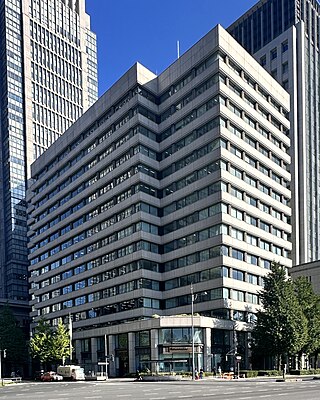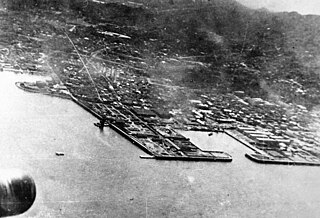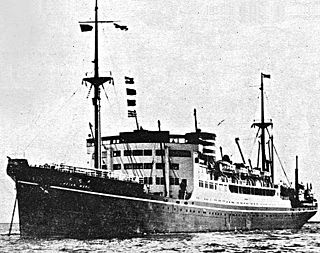
Bakumatsu was the final years of the Edo period when the Tokugawa shogunate ended. Between 1853 and 1867, under foreign diplomatic and military pressure, Japan ended its isolationist foreign policy known as sakoku and changed from a feudal Tokugawa shogunate to the modern empire of the Meiji government. The major ideological-political divide during this period was between the pro-imperial nationalists called ishin shishi and the shogunate forces, which included the elite shinsengumi swordsmen.

Mitsubishi Heavy Industries, Ltd. is a Japanese multinational engineering, electrical equipment and electronics corporation headquartered in Tokyo, Japan. MHI is one of the core companies of the Mitsubishi Group and its automobile division is the predecessor of Mitsubishi Motors.

Thomas Blake Glover was a Scottish merchant in the Bakumatsu and Meiji period in Japan.

The Nippon Yusen Kabushiki Kaisha, also known as NYK Line, is a Japanese shipping company. The company headquarters are located in Chiyoda, Tokyo, Japan. It operates a fleet of over 800 ships, which includes container ships, tankers, bulk and woodchip carriers, roll-on/roll-off car carriers, reefer vessels, LNG carriers, and cruise ships. It is a member of the Ocean Network Express and Mitsubishi Group.

The foreign cemeteries in Japan are chiefly located in Tokyo and at the former treaty ports of Kobe, Hakodate, Nagasaki, and Yokohama. They contain the mortal remains of long-term Japan residents or other foreigners who died in Japan, and are separate from any of the military cemeteries.

Joseph Heco was the first Japanese person to be naturalized as a United States citizen and the first to publish a Japanese language newspaper.
Sophia Wilson was a Japanese courtesan who married Captain John Wilson. She anglicised her name from Naka Yamazaki to Sophia Wilson, and adopted her son, Nils Wilson. Upon her marriage, she renounced her membership in the Yamazaki koseki, or family record, became a Swedish citizen, and was baptized in the Church of England (Anglican).
Sweden v. Yamaguchi, otherwise known as in the matter of Marianne Wilson, or in the matter of Mary Ann Vaughn, is a highly complex decision in international family law which touches on questions in law still unresolved over fifty years later. The formal name of the action was Israel Karl-Gustav Eugene Lagerfelt v. Yamaguchi Masakatsu and Yamaguchi Hideko, or Case of Demand for Delivery of an Infant, No. Wa-154, 1956 Yokohama District Court, initiated February 22, 1956. On December 5, 1956, it held that the defendants should deliver the infant to the plaintiff. The appeal was dismissed by Tokyo High Court on July 9, 1958.
Mary Ann Vaughn, a.k.a. Marianne Wilson, is a citizen of Sweden who was the subject of a widely publicised and highly controversial case in international family law decided in the Tokyo High Court in 1956, Sweden v. Yamaguchi. Vaughn became the ward of the Swedish Ambassador to Japan, Tage Grönwall and later Karl Fredrik Almqvist, and resided in the Swedish Embassy in Tokyo.

Chōyō Maru was an early sail and screw-driven steam corvette. She was ordered by the Tokugawa shogunate ruling Japan during the Bakumatsu period from the Netherlands and served as a training vessel, and subsequently served with the nascent Imperial Japanese Navy during the Boshin War. She was lost in combat during the Naval Battle of Hakodate Bay.

Shinano Maru (信濃丸) was a 6,388 GRT merchantman operated by the Nippon Yusen K.K Shipping Company (NYK). She was built by W. Henderson Co in Glasgow, for the express purpose of serving NYK's Japan to Seattle route. NYK originally intended that she be built at the Mitsubishi Nagasaki shipyards in Japan; however, Mitsubishi had experienced problems in the completion of Hitachi Maru, which had led to considerable delays. NYK chose not to wait, and Shinano Maru was ordered to Scotland. She was completed in April 1900. During the Russo-Japanese War Shinano Maru was converted into an armed merchantman. She has the distinction of discovering the Russian Fleet near Tsushima Strait on the eve of the Battle of Tsushima. After the war Shinano Maru reverted to civilian use, being scrapped in 1951.

Hikawa Maru (氷川丸) also known as Cordoba after leased to Nicaraguan shipping company Lloyd Nicaragüense in 1952 is a Japanese ocean liner that Yokohama Dock Company built for Nippon Yūsen Kabushiki Kaisha. She was launched on 30 September 1929 and made her maiden voyage from Kobe to Seattle on 13 May 1930. She is permanently berthed as a museum ship at Yamashita Park, Naka-ku, Yokohama.

Asama Maru was a Japanese ocean liner owned by Nippon Yusen Kaisha (NYK). The ship was built in 1927–1929 by Mitsubishi Shipbuilding & Engineering Co. at Nagasaki, Japan. The vessel was named after an important Shinto shrine.

Tatsuta Maru (龍田丸), was a Japanese ocean liner owned by Nippon Yusen Kaisha (NYK). The ship was built in 1927–1929 by Mitsubishi Shipbuilding & Engineering Co. at Nagasaki, Japan. The vessel was named after Tatsuta Jinja an important Shinto shrine in Nara Prefecture.

Yokosuka Naval District was the first of four main administrative districts of the pre-war Imperial Japanese Navy. Its territory included Tokyo Bay and the Pacific coasts of central and northern Honshū from the Kii Peninsula to Shimokita Peninsula. Its headquarters, along with most of its installations, including the Yokosuka Naval Arsenal, were located in the city of Yokosuka, which constituted the Yokosuka Naval Base.

The Terukuni Maru-class ocean liner was a class of ocean liners of Japan, serving during the 1930s, and into World War II.

Terukuni Maru (照国丸) was a Japanese ocean liner owned by Nippon Yusen Kaisha (NYK). The ship was launched in 1929 by Mitsubishi Shipbuilding & Engineering Co. at Nagasaki, on the southern island of Kyūshū, Japan, entering service in 1930. She sank off the English coast in 1939 after striking a mine. Her sinking has been described as Japan's only World War II casualty outside East Asia before the 1941 attack on Pearl Harbor.

Yasukuni Maru (靖国丸) was a Japanese ocean liner owned by Nippon Yusen Kaisha (NYK). The ship was launched in 1930 by Mitsubishi Shipbuilding & Engineering Co. at Nagasaki, on the southern island of Kyūshū, Japan, entering service in 1930. The ship was named for the Yasukuni Shrine, a famous Shinto shrine dedicated to the war dead of Japan, located in Tokyo.

Heian Maru (平安丸) was a Japanese ocean liner launched in 1930 and operated primarily on the NYK line's trans-Pacific service between Yokohama and Seattle. Shortly before the outbreak of the Pacific War, it was requisitioned by the Imperial Japanese Navy and converted to use as an auxiliary submarine tender. In 1944 it was sunk by American aircraft at Chuuk Lagoon during Operation Hailstone. Its submerged hulk – the largest of Chuuk's "Ghost Fleet" – remains a popular scuba diving destination.

Suwa Maru (諏訪丸) was a Japanese passenger/cargo ship owned by Nippon Yusen Kaisha (NYK). The ship was launched in 1914 by Mitsubishi Shipbuilding & Engineering Co. at Nagasaki, Japan. The ship was named for the Suwa Jinja, a noted Shinto shrine located in Suwa, Nagano. In July 1941 the ship was taken into military service, and after being struck by torpedoes was beached on Wake island in the Pacific in 1943. Since it was able to beach there was not much loss of life, though the ship was later struck again a few months later and the wreck visible for many years after the war.















